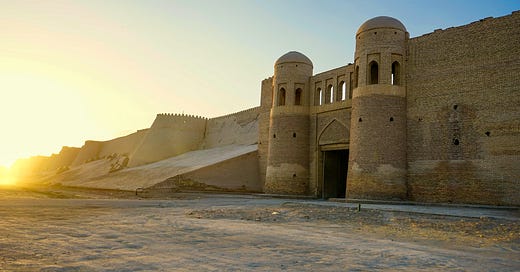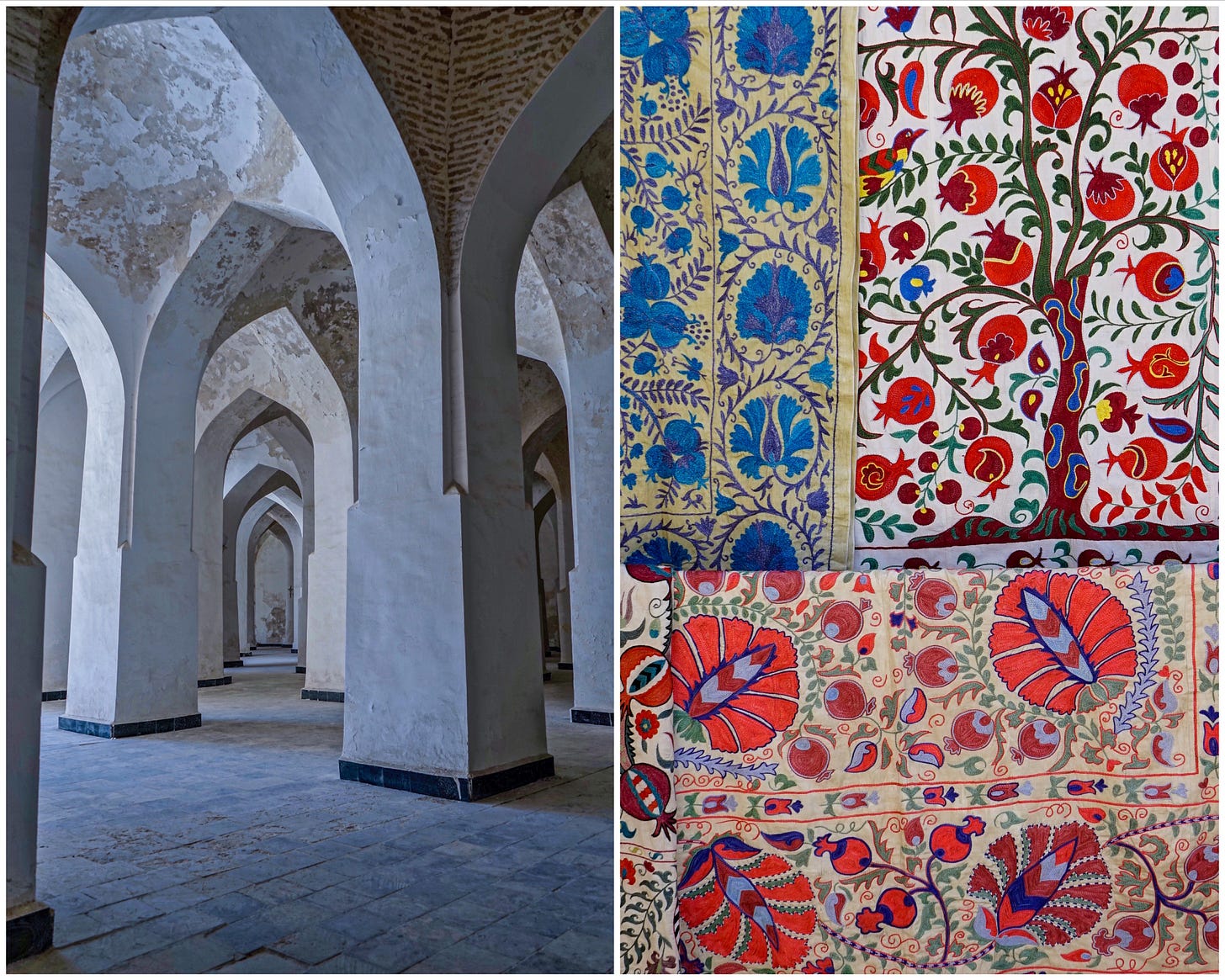The Shock of the Old: Uzbekistan's Silk Road
A necropolis of mosaic domes, a walled city in the Kyzl Kum Desert, a fairytale mosque carved from ancient trees, an enormous fiery gas crater
Samarkand. Bokhara. Khiva. Whisper the names of these three glittering cities along Uzbekistan’s fabled Silk Road and people lean in a little closer. Linked like beads in a necklace along a trade route crisscrossing vast sandy wastelands, these ancient metropolises were yesterday’s glamorous outposts of chic, delivering exotic silks, ceramics, carpets and embroidered textiles to the Western world.
This week’s newsletter is two-fold, beginning with an interview that ran in YOLO Journal about the trip to Uzbekistan I took with my friend Belinda Carlisle, and finishing up with my Silk Road list of must-sees.
PART ONE: FROM YOLO JOURNAL // THE SILK ROAD
Over two decades, Lisa Borgnes Giramonti and Belinda Carlisle have traveled the world together, hitting countries from Kazakhstan to India. When I met them and they told me about their annual trips (neither of their husbands have the bug the way they do), I was mildly obsessed. They are always researching destinations, finding places that people don’t typically visit. Once they decide on a place, they read everything they can on it, digging deep into the history, the art, the food. To be always in a travel mindset, always learning something new — and to have a pal to share it with — is pretty special. —Yolanda Edwards
YOLO: How did Uzbekistan and Turkmenistan come about?
Belinda: For the last few years I’ve been obsessed with Central Asia. There’s so much exotic history. It was the main artery of civilization 2,000 years ago between China and Europe. Reading Peter Frankopan’s book The Silk Road put it over the edge for me. That and all the incredible documentaries I found on YouTube.
Lisa: I had been reading old memoirs by Ella Maillart and Peter Fleming who went to Central Asia when it was really difficult to travel there. So I was gripped by the personal aspect of how places like that can challenge and change you.
B: It’s not a normal destination. Especially a country with the name “stan” on the end of it. Which only means “land of.” It’s not like a big scary thing. It just means land of Uzbeks, land of Turkmen, land of Kazakhs. But we’re conditioned to be wary of these places because they’re unfamiliar.
YOLO: Highlights of the trip, and some tales around the adventure?
B: The Shah-i-Zinda necropolis in Samarkand with its huge turquoise-domed mausoleums looked like a Central Asian Oz. In Khiva, we took a little golf cart around the fortress at dusk. The driver was blasting Uzbekistan disco music, we were driving through little neighborhoods, children were running after us waving, and the sun was setting over the ancient walled city. There was this incredible golden light. I’ll never forget it.
L: I loved the Djuma Mosque in Khiva with its columns built from ancient trees. It was like a spiritual forest. In Turkmenistan, we camped out at the Darvaza gas crater in the Karakum desert. Imagine a vast barren sandscape and in the middle of it this enormous flame-spewing crater. And us in a tiny pup tent, sweltering.
B: We would walk down to the crater at night and be blasted by waves of fiery heat. They call it “The Door to Hell” for a reason. We went a little outside our comfort zone on that one.
L: We did. We were afraid to drink too much water because we didn’t want to meet any snakes or camel spiders if we had to seek a patch of sand in the middle of the night. Our guide told us that a Russian gangster he knew had a camel spider design tattooed on his hand because the pain of its bite had forever defined him.
B: Another Turkmenistan highlight was definitely the ancient city of Merv. We had the entire place to ourselves. Right when we got there, a sandstorm kicked up. The wind was whipping at our backs, there was thunder and lightning. It was like the gods were giving us a show. And there we were standing on the walls of a Zoroastrian fortress looking at the ruins of a city that was once on par with Cairo.
L: I kept thinking of that poem Ozymandias. “Look on my works, ye mighty, and despair.”
B: It made you think about the impermanence of things and that if we really studied our history maybe we could avoid making the same mistakes over and over. Because great civilizations, they rise and they inevitably fall. Always.
Keep reading with a 7-day free trial
Subscribe to In Hand to keep reading this post and get 7 days of free access to the full post archives.









